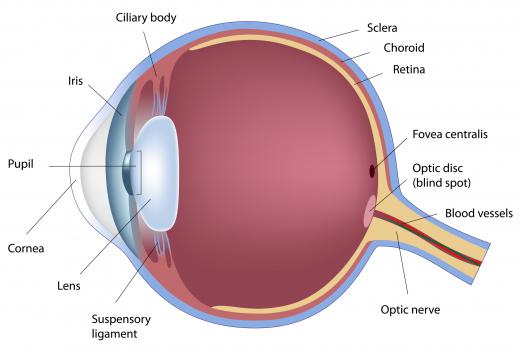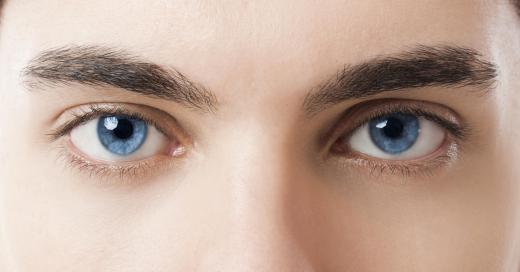How does a Retinal Scan Work?
 Michael Anissimov
Michael Anissimov
Used almost exclusively in high-end security applications, the retinal scan uses a low-intensity light source and a delicate sensor to scan the pattern of blood vessels at the back of the retina, a pattern unique to each individual. Though it was known as early as the 1930s that each human eyeball had unique characteristics, it was not until 1984 that the first retinal scanner was made available for commercial use. It was produced by EyeDentify, a company formed in 1976, still the primary manufacturer of these devices.
During a retinal scan, the user must remove glasses, stare at a specific point, and hold their head still for the 10-15 seconds it takes to complete the scan. This type of scan is very difficult to fake because no technology exists that allows the forgery of a human retina, and the retina of a deceased person decays too fast to be used to fraudulently bypass such a scan.

Retinal scanning is part of biometrics, the field of science and engineering which develops ways to uniquely identify individual persons. The most popular form of biometrics employed today is of course the fingerprint, though the error rate for fingerprint identification is sometimes as high as 1 in 500. A retinal scan, on the other hand, boasts an error rate of 1 in 10,000,000. Its close cousin, the iris scan, is slightly less precise, maintaining an error rate of approximately 1 in 131,000.

Traditionally used to block physical gateways, such as those guarding the cores of power plants or military installations, retinal scanning has been employed in recent times to safeguard critical computers and their data. The retinal scan retails for as low as $220, making it affordable to anyone wanting to maintain high levels of security. Furthermore, it is probably the most accurate biometric available, far surpassing the fingerprint in both reliability and accuracy.
AS FEATURED ON:
AS FEATURED ON:












Discussion Comments
@anon69778: Yes there are such things as clones!
Proof #1) Dolly the sheep
Proof #2) Star Wars: The Clone Wars
@anon69778 - tell dolly the sheep that there are no clones.
So if a person develops diabetic or hypertensive retinopathy, would their blood vessels change so much that the retinal scan would not recognize the original retina?
Scientists like to claim they've created clones through genetic egg cell implants. The truth is that this isn't cloning. It's making a younger version (though realistically it's the same age) of the animal.
Even if they did this on humans, fingerprints would still be different, so would eye retinas. Identical twins are the closest to clones there is, and they still have different eye retina patterns and fingerprint patterns.
There are no such things as clones.
What are the advantages and disadvantages of hand geometry over finger print technology?
no two individuals or twins have same retina patterns. xzm
to -anon19934
Advantages over fingerprints:
-more accurate, (accuracy not effected by dirt on fingers, misplaced fingers, etc..)
-uses less data space
-fast and impossible (for now) to fake
Disadvantages over fingerprints:
-slightly more expensive then basic fingerprint reader
-user has to put their face next to the machine and focus on a retina scanner for 3 seconds
Thank you very much this was very helpful. do you happen to know what are the disadvantages and advantages over the use of fingerprints??
do clones have the same retina pattern?
Post your comments